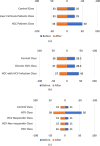Circulating miRNA's biomarkers for early detection of hepatocellular carcinoma in Egyptian patients based on machine learning algorithms
- PMID: 38424116
- PMCID: PMC10904762
- DOI: 10.1038/s41598-024-54795-2
Circulating miRNA's biomarkers for early detection of hepatocellular carcinoma in Egyptian patients based on machine learning algorithms
Abstract
Liver cancer, which ranks sixth globally and third in cancer-related deaths, is caused by chronic liver disorders and a variety of risk factors. Despite therapeutic improvements, the prognosis for Hepatocellular Carcinoma (HCC) remains poor, with a 5-year survival rate for advanced cases of less than 12%. Although there is a noticeable decrease in the frequency of cases, liver cancer remains a significant worldwide health concern, with estimates surpassing one million cases by 2025. The prevalence of HCC has increased in Egypt, and it includes several neoplasms with distinctive messenger RNA (mRNA) and microRNA (miRNA) expression profiles. In HCC patients, certain miRNAs, such as miRNA-483-5P and miRNA-21, are upregulated, whereas miRNA-155 is elevated in HCV-infected people, encouraging hepatocyte proliferation. Short noncoding RNAs called miRNAs in circulation have the potential as HCC diagnostic and prognostic markers. This paper proposed a model for examining circulating miRNAs as diagnostic and predictive markers for HCC in Egyptian patients and their clinical and pathological characteristics. The proposed HCC detection model consists of three main phases: data preprocessing phase, feature selection based on the proposed Binary African Vulture Optimization Algorithm (BAVO) phase, and finally, classification as well as cross-validation phase. The first phase namely the data preprocessing phase tackle the main problems associated with the adopted datasets. In the feature selection based on the proposed BAVO algorithm phase, a new binary version of the BAVO swarm-based algorithm is introduced to select the relevant markers for HCC. Finally, in the last phase, namely the classification and cross-validation phase, the support vector machine and k-folds cross-validation method are utilized. The proposed model is evaluated on three studies on Egyptians who had HCC. A comparison between the proposed model and traditional statistical studies is reported to demonstrate the superiority of using the machine learning model for evaluating circulating miRNAs as diagnostic markers of HCC. The specificity and sensitivity for differentiation of HCC cases in comparison with the statistical-based method for the first study were 98% against 88% and 99% versus 92%, respectively. The second study revealed the sensitivity and specificity were 97.78% against 90% and 98.89% versus 92.5%, respectively. The third study reported 83.2% against 88.8% and 95.80% versus 92.4%, respectively. Additionally, the results show that circulating miRNA-483-5p, 21, and 155 may be potential new prognostic and early diagnostic biomarkers for HCC.
Keywords: Hepatocellular carcinoma; Liver cancer; Machine learning; Swarm optimization; miRNA.
© 2024. The Author(s).
Conflict of interest statement
The authors declare no competing interests.
Figures





Similar articles
-
Development and Validation of a Novel Circulating miRNA-Based Diagnostic Score for Early Detection of Hepatocellular Carcinoma.Dig Dis Sci. 2022 Jun;67(6):2283-2292. doi: 10.1007/s10620-021-07031-0. Epub 2021 May 12. Dig Dis Sci. 2022. PMID: 33982217
-
Circulating miRNA-122, miRNA-199a, and miRNA-16 as Biomarkers for Early Detection of Hepatocellular Carcinoma in Egyptian Patients with Chronic Hepatitis C Virus Infection.Mol Diagn Ther. 2015 Aug;19(4):213-20. doi: 10.1007/s40291-015-0148-1. Mol Diagn Ther. 2015. PMID: 26133725
-
Plasma miRNAs as early biomarkers for detecting hepatocellular carcinoma.Int J Cancer. 2015 Oct 1;137(7):1679-90. doi: 10.1002/ijc.29544. Epub 2015 Apr 21. Int J Cancer. 2015. PMID: 25845839 Clinical Trial.
-
The biological and diagnostic role of miRNA's in hepatocellular carcinoma.Front Biosci (Landmark Ed). 2018 Mar 1;23(9):1701-1720. doi: 10.2741/4668. Front Biosci (Landmark Ed). 2018. PMID: 29293458 Review.
-
Circulating microRNAs as diagnostic and prognostic tools for hepatocellular carcinoma.World J Gastroenterol. 2015 Sep 14;21(34):9853-62. doi: 10.3748/wjg.v21.i34.9853. World J Gastroenterol. 2015. PMID: 26379392 Free PMC article. Review.
Cited by
-
Advancing Cholangiocarcinoma Diagnosis: The Role of Liquid Biopsy and CRISPR/Cas Systems in Biomarker Detection.Cancers (Basel). 2025 Jun 26;17(13):2155. doi: 10.3390/cancers17132155. Cancers (Basel). 2025. PMID: 40647454 Free PMC article. Review.
-
Recent Advances in miRNA-Based Therapy for MASLD/MASH and MASH-Associated HCC.Int J Mol Sci. 2024 Nov 14;25(22):12229. doi: 10.3390/ijms252212229. Int J Mol Sci. 2024. PMID: 39596297 Free PMC article. Review.
-
A Systematic Review of the Outcomes of Utilization of Artificial Intelligence Within the Healthcare Systems of the Middle East: A Thematic Analysis of Findings.Health Sci Rep. 2024 Dec 24;7(12):e70300. doi: 10.1002/hsr2.70300. eCollection 2024 Dec. Health Sci Rep. 2024. PMID: 39720235 Free PMC article. Review.
-
Machine Learning Approach and Bioinformatics Analysis Discovered Key Genomic Signatures for Hepatitis B Virus-Associated Hepatocyte Remodeling and Hepatocellular Carcinoma.Cancer Inform. 2025 Apr 16;24:11769351251333847. doi: 10.1177/11769351251333847. eCollection 2025. Cancer Inform. 2025. PMID: 40291818 Free PMC article. Review.
-
Machine-Learning-Based Identification of Key Feature RNA-Signature Linked to Diagnosis of Hepatocellular Carcinoma.J Clin Exp Hepatol. 2024 Nov-Dec;14(6):101456. doi: 10.1016/j.jceh.2024.101456. Epub 2024 Jun 14. J Clin Exp Hepatol. 2024. PMID: 39055616
References
-
- Bose PP, Chatterjee U. Advances in early diagnosis of hepatocellular carcinoma. Hepatoma Res. 2019;5:24.
MeSH terms
Substances
Supplementary concepts
LinkOut - more resources
Full Text Sources
Medical

